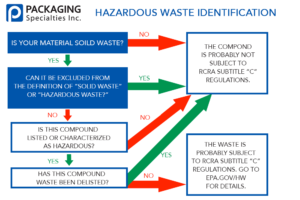The regulations for shipping hazardous materials is closely monitored by the U.S. Department of Transportation. Before shipping a hazardous material, you are responsible for ensuring the proper steps have been taken to protect your shipment, and the carrier, from the potential hazards associated with your shipment. The process outlined below offers a general overview of what you need to do before shipping hazardous materials. For more information on hazmat transportation regulations, be sure to contact the Hazardous Materials Information Center.
 Step One: Locate Hazardous Material on the Hazardous Materials Table
Step One: Locate Hazardous Material on the Hazardous Materials Table
Perhaps the most important step in properly shipping hazardous materials is identifying the type of hazardous material you are shipping and locating it on the Hazardous Materials Table. The most effective way to do this is to look up the product’s Safety Data Sheet (SDS), often found online, which provides all the information you will need to determine how to properly ship the material. This information, including the four-digit ID number, a proper shipping name, the hazard class, and the packing group for the product, will help you identify the material on the Hazardous Materials Table. From there, the Hazardous Materials Table will specify appropriate packaging, quantity limitations, and any special requirements for shipping that particular hazardous material.
Step Two: Determine Appropriate Packaging for the Hazardous Material
Using the Hazardous Materials Table as a guide, you will need to select the appropriate packaging for the amount of hazardous material you are intending to ship. In some cases, depending of the type and quantity of the material being shipped, performance packaging (UN Standard or DOT-Specification packaging) may be needed. Be sure to follow these guidelines carefully to ensure the safety of the carrier as well as your shipped goods.
Step Three: Package Hazardous Material
Using the appropriate packaging determined by the type and quantity of hazardous materials being shipped, package your materials, being careful to adhere to the manufacturer’s directions for assembling and closing the selected packaging. It is important, especially when performance packaging is required, to follow these guidelines exactly – including using the inner and outer packaging as well as closure materials – to avoid releasing hazardous materials into the environment, in the event of a spill. Performance packaging is designed and tested to contain hazardous materials during a spill; deviating from the proper use of this packaging may compromise the integrity of your shipment.
Step Four: Label Hazardous Material Packaging
As specified by the Hazardous Materials Table, you will need to apply the appropriate labels to your package, which serve to alert your carrier about how to properly and safely transport your hazardous material. These markings can include orientation labels, shipper’s information, and hazard class labels.
Step Five: Prepare Hazardous Material Shipping Paper (if needed)
If such a requirement is specified in the Hazardous Materials Table, you will need to prepare a shipping paper that provides information about the hazardous material you are shipping. Such information may include a description of the material, the UN identification number, shipping name, hazard class, packing group, and quantity. Sometimes more information is required, depending on the hazardous material being shipped.
Step Six: Ship Hazardous Material with Approved Carrier
You will want to work closely with your chosen carrier to identify and provide any additional carrier requirements that will ensure your hazardous material arrives safely at its destination.
Questions about Safely Shipping Hazardous Material
Do you have specific packaging needs for shipping hazardous materials? Contact us today to see how we can provide the packaging you need to ensure your shipment properly adheres to the US Department of Transportation’s guidelines.


Recent Comments